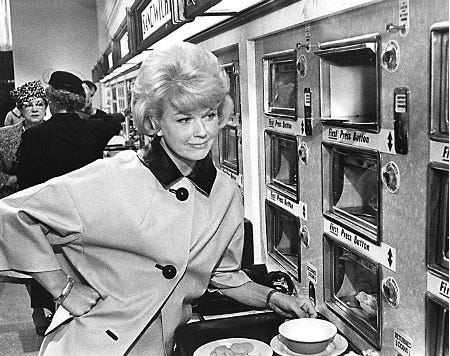Now it’s Only in Old Movies
Science and technology developed quickly in the 20th century, and continue to do so today. Some things that were familiar decades ago no longer exist. This is probably a good thing. Outdated stuff should be discarded in favor of better, newer ideas. And some of these old effects are memorialized in the movies.
An example of this is telephone “party lines.” Party lines were shared telephone lines. According to Wikipedia, the rise in demand for phone lines after WWII, led to a growth in the use of this technology, although it caused problems, including busy signals and a lack of privacy.1 This is the premise in “Pillow Talk” (1959, a romantic comedy starring Doris Day and Rock Hudson). Here, Jan Morrow (Day), a busy interior decorator in New York City shares a party line with Brad Allen (Hudson), a womanizing pianist. Jan can rarely place or receive calls because Brad monopolizes the phone line. And what is worse, they are able to listen in on each other’s conversations, eliminating a sense of privacy one would expect in making phone calls. Although the concept is humorous in the film, few people would tolerate party lines today.
In “That Touch of Mink,” (1962, again starring Doris Day), we see another form of technology that has become rare: an automat. Cathy Timberlake (Day) is a career woman seeking a job in New York City. After a Rolls Royce splashes her with mud, Cathy becomes frustrated that the car’s passenger (Cary Grant) fails to stop and apologize for ruining her clothes. Cathy goes to lunch at an automat nearby, where her roommate, Connie (Audrey Meadows), works. Connie passes Cathy (unpaid) food through the little window, so she can eat. Connie and other workers can be seen behind the automat filling the tiny compartments during the film.2 One might be surprised to see the use of regular plates and silverware accompanying the entrees (as opposed to disposable plates and cutlery). Apparently, automats were replaced by vending machines and fast-food restaurants in the U.S. by mid-century, probably as a cost-cutting measure.
Many films of yesteryear feature the presence of elevator operators, an example of which is “The Maltese Falcon” (1940). When elevators first appeared, operators were needed due to their manual function. They were often controlled by a large lever, and the operator had to regulate the elevator’s speed. This job often required a good sense of timing and also some training in terms of operation and safety.3 The profession became almost completely obsolete—as is true of switchboard operators—with the advent of automation.
Another form of obsolescence has more to do with chemistry than technology: the use of bromides in daily life. Bromide compounds, such as potassium bromide, were often taken as sedatives in the 19th and early 20th centuries. They were withdrawn from use by 1975 in the U.S. due to chronic toxicity.4 In “The Women” (1939), a distraught Countess Flora De Lave (Mary Boland), calls out for a bromide when she discovers that her latest husband is in love with another woman. Humorously, she requests that gin be added to the concoction, as she is frequently found drinking in the film.5
Movies capture the habits, mores, and technology of the era in which they were created. They become time capsules in this regards, chronicling the fashions, concerns, and ideas of their generation. They transform into historical records quickly, cementing bygone eras into the imagination for the future.
Copyright © 2024 by Rosi Prieto, Ph.D.
All Rights Reserved
https://en.wikipedia.org/wiki/Party_line_(telephony)
https://en.wikipedia.org/wiki/Automat
https://en.wikipedia.org/wiki/Elevator_operator
https://en.wikipedia.org/wiki/Bromide
The sedative is also mentioned in My Man Jeeves: Bertie encounters an angry dog in his apartment that Jeeves soothes with his mere presence, “. . . his magnetism or whatever they call it was such that the dashed animal, instead of pinning him by the leg, calmed down as if he had had a bromide, and rolled over on his back with all his paws in the air,” P. G. Wodehouse, My Man Jeeves, (London: George Newnes), 57.





